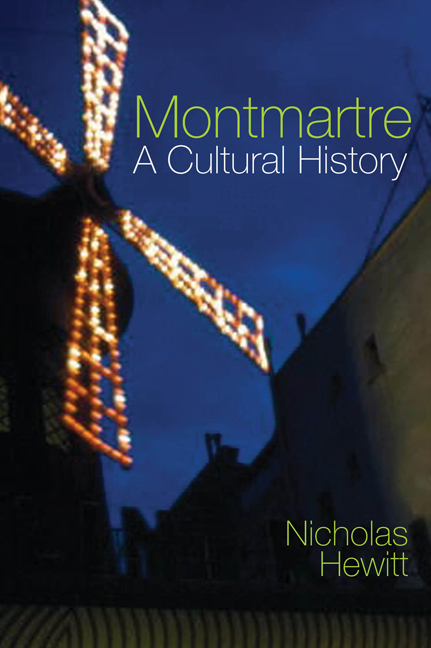Book contents
- Frontmatter
- Dedication
- Contents
- List of Illustrations
- Acknowledgements
- Map
- Introduction
- 1 ‘Montons à la Barrière’
- 2 The Artistic Cabarets
- 3 Music Halls and Mass Culture
- 4 Theatre and the Avant-Garde
- 5 The Bateau-Lavoir and the Lapin Agile
- 6 Wartime and the Années Folles
- 7 The Place of Memory
- 8 The Ecole de Montmartre
- 9 The Occupation: Céline and Aymé
- Epilogue: Montmartre on Film
- Bibliography
- Index
- Plate section
1 - ‘Montons à la Barrière’
- Frontmatter
- Dedication
- Contents
- List of Illustrations
- Acknowledgements
- Map
- Introduction
- 1 ‘Montons à la Barrière’
- 2 The Artistic Cabarets
- 3 Music Halls and Mass Culture
- 4 Theatre and the Avant-Garde
- 5 The Bateau-Lavoir and the Lapin Agile
- 6 Wartime and the Années Folles
- 7 The Place of Memory
- 8 The Ecole de Montmartre
- 9 The Occupation: Céline and Aymé
- Epilogue: Montmartre on Film
- Bibliography
- Index
- Plate section
Summary
In the beginning was the Wall. As is well known, the Mur des Fermiers Généraux was constructed in 1784 as a customs barrier which split a Parisian population of some 600,000: the mass of the population remained behind the wall, condemned to pay higher taxes, while those who lived in the communes limitrophes, like La Chapelle-Saint-Denis or Montmartre, which had a population of less than 400 in 1790, benefited from relatively light taxation. It was this tax differential which was to be so crucial in the development of pleasure centres on the Parisian periphery. Along the wall there were two sets of roads: the chemins de ronde on the inside and, outside, the boulevards extérieurs. In the north, the wall, with its accompanying roads, followed the route of the future Boulevard des Batignolles, Boulevard de Clichy, Boulevard de Rochechouart and Boulevard de la Chapelle, while in the south it established the line of the Boulevard du Montparnasse.
At regular intervals, there were breaks in the wall allowing access to the capital from the communes limitrophes and further afield, and vice versa. Here the Fermiers Généraux established their barrières, crossing points with customs posts where those bringing produce into Paris were obliged to pay duty. It was precisely at these crossing points, however, that the Parisian population had access to cheaper products from the other side of the wall, the most significant of which was wine, which was highly taxed within the capital. It is also significant that, until rail transport made possible the mass importation of wine from the south, the area around Paris had been important for wine production. A document of 1790, referring to Montmartre, reports that ‘it is in this district, and some others, that there is consumption of wine from the pays François, the region of Mantes, the Gâtinais, the regions of Orléans and Blois and Lower Burgundy’. This relatively local wine, which included that produced in Montmartre itself, was the basis of an extensive pleasure trade which established itself around Paris in the ‘zone situated near the “barriers”, which contained a large number of dance halls, taverns and amusement places’.
- Type
- Chapter
- Information
- MontmartreA Cultural History, pp. 15 - 34Publisher: Liverpool University PressPrint publication year: 2017



